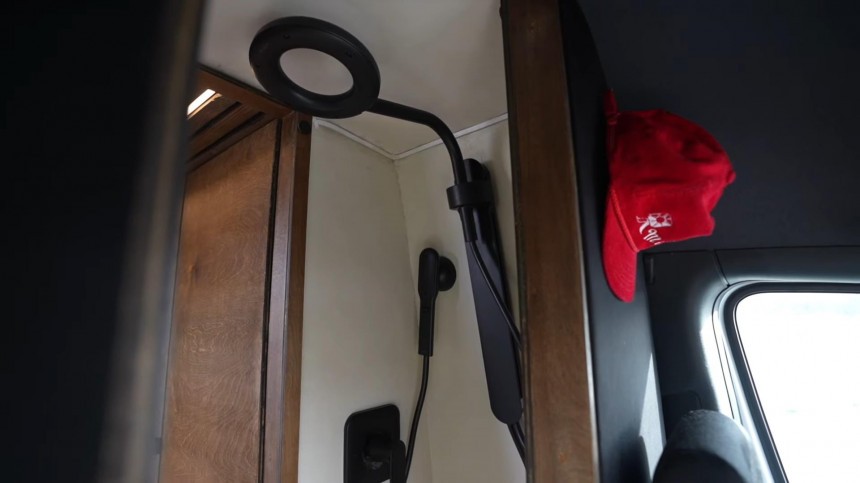There are a lot of campers out there, but not all of them are capable of handling winter conditions. Unless you live somewhere that doesn't get cold at all, I think it's generally a good idea to make your rig four-season. Today we're checking out a winter-proof Sprinter van build that's the ideal blend of beauty and practicality.

Photo: YouTube Screenshot / Nate Murphy
Meet Ramsey and Caleb, a young couple who converted a 170-inch wheelbase 2023 Mercedes-Benz Sprinter into a cozy little house on wheels. After his first year and a half of traveling in a van, they planned to build their dream. The main purpose of this building was to serve as a ski adventure base.
They started it and 44 days later the project was completed. I don't know if you know how long it usually takes to build a camper, but trust me, 44 days is really fast. But Caleb treated the production like a full-time job, and more than that, working from sunup to sundown.
This Sprinter van looks pretty standard, finished in white paint, and could even be used for stealth camping. The only indicators of a campervan's DNA are the solar panels on its roof, but only a keen eye can spot them.
The real magic of this build happens under the hood. Pop open the sliding door and you'll see that the utility closet occupies part of the entryway. This space is designed to accommodate snowboards, skis, and other bulky winter gear. Additionally, the compartments are lined with neoprene, making them waterproof.

Photo: YouTube Screenshot / Nate Murphy
As for the design, the couple chose walnut cabinetry paired with almost sand-gray walls and rough-textured Roman clay countertops. I love its aesthetic, especially the many dimmable LED strips on the top and bottom that create a calm and cozy atmosphere. To the ceiling, Ramsey and Caleb added walnut slats on black-painted plywood sheets.
The first thing you see when you step inside is the kitchen, which is divided into two parts. There's plenty of counter space, a two-burner induction cooktop, a deep sink with an additional filtering faucet, and plenty of storage space in the form of drawers and cabinets.
One large drawer houses an Iceco 75-liter (almost 20-gallon) refrigerated/freezer box, which the couple said can store three weeks' worth of food. Additionally, the cabinet under the sink houses a Thetford toilet mounted on a drawer slide.
The space next to the vanity on the driver's side is taken up by two huge closets, where the couple stores all their clothing. There are many drawers underneath, one of which has an outlet and can also be used for charging.

Photo: YouTube Screenshot / Nate Murphy
Unlike many other campers, this rig's shower is located in the corner next to the cab door. It features his water-saving Nebula shower head and handheld wand. One design touch that I really like is that the couple used Roman clay to cover the walls, creating a beautiful textured look. By the way, the water comes from a 40-gallon (151 liter) freshwater tank connected to the water heater.
The final part of the living space is the lounge/bedroom area. It consists of two long benches with custom-made mattresses, a huge rotating table and two large windows with blackout shades. Furthermore, by attaching a table between the benches and rearranging the cushions, you can use it as a guest bed.
You'll notice that the ceiling here is closer than the rest of the van. This is because the ceiling is actually the elevator bed. Lower or raise the elevator bed with the push of a button. I'm a big fan of elevator beds in vans. Because it saves a lot of space.
Lastly, I would like to explain in detail the utility system of this camper. The purpose of this construction was to create a mobile home perfect for winter sports. In this regard, the couple added hot showers and underfloor heating. For cooling, you can use a ceiling-mounted Dometic air conditioner.

Photo: YouTube Screenshot / Nate Murphy
This rig's electrical system is so powerful that the couple can go off the grid. It has a lithium battery with a capacity of 900 Ah, a DC-DC charger (enables charging the system while driving), a 3,000 W inverter and a solar charge controller connected to a 600 W solar panel on the roof. It has been constructed.
Overall, Ramsey and Caleb did a great job with this Sprinter van conversion. My favorite parts are the beauty of the interior and the waterproof utility closet for storing winter sports gear. Furthermore, using the elevator opens up the back area, creating a spacious lounge.



